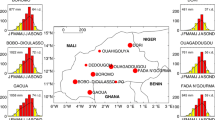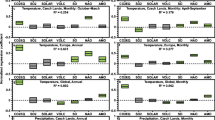Summary
The Siberian High is the most important atmospheric centre of action in Eurasia during the winter months. Here its variability and relationship with temperature and precipitation is investigated for the period 1922 to 2000. The pronounced weakening of the Siberian High during the last ∼ 20 years is its most remarkable feature. Mean temperature, averaged over middle to high latitude Asia (30° E–140° E, 30° N–70° N), is correlated with the Siberian High central intensity (SHCI) with correlation coefficient of − 0.58 (1922–1999), and for precipitation, the correlation coefficient is − 0.44 (1922–1998). Taking the Arctic Oscillation (AO), the SHCI, the Eurasian teleconnection pattern (EU), and the Southern Oscillation (SO) index into account, 72 percent of the variance in temperature can be explained for the period 1949–1997 (for precipitation the variance is 26 percent), with the AO alone explaining 30 percent of the variance, and the Siberian High contributing 24 percent. The precipitation variance explained by the Siberian High is only 9.8 percent of the total.
Similar content being viewed by others
Author information
Authors and Affiliations
Additional information
Received January 2, 2001 Revised November 24, 2001
Rights and permissions
About this article
Cite this article
Gong, DY., Ho, CH. The Siberian High and climate change over middle to high latitude Asia. Theor Appl Climatol 72, 1–9 (2002). https://doi.org/10.1007/s007040200008
Issue Date:
DOI: https://doi.org/10.1007/s007040200008




